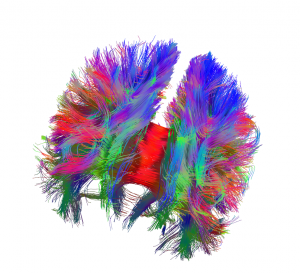If the underlying labeled graph structure of spatial knowledge includes some metric information, what is the mechanism used to acquire that local metric information?
A likely candidate is path integration, the continual updating of position and orientation during movement in an environment. We have studied path integration from a number of different angles. For example, we found evidence that navigators preferably use body-based information about self-motion to gauge distances and angles during path integration. We also found that errors in executing a desired trajectory tend to make a larger contribution in path integration errors than do errors in encoding the outbound path.
In the brain, we found activation that could support a homing vector for path integration, a process that keeps track of a navigator’s Euclidean (straight-line) distance relative to their start location during movement in a landmark-free environment. The hippocampus, retrosplenial cortex, and parahippocampal cortex had fMRI activation consistent with a homing vector. These same regions also supported memory for simple straight-line translation and rotation in place by tracking the magnitude of translation or rotation during virtual self-motion. We also have found signals important for heading direction and have uncovered functional connections between optic flow areas—which process visual information about changes in heading—and regions important for path integration, including hippocampus and retrosplenial cortex.
This research is sponsored by the National Science Foundation (CogNeuro)
*Collaborators: Chantal Stern (Boston University), Sam Ling (Boston University), Bill Warren (Brown)
Selected Publications:
Chrastil, E.R., & Warren, W.H. (2021). Executing the homebound path is a major source of error in homing by path integration. Journal of Experimental Psychology: Human Perception and Performance.
Chrastil, E.R., Nicora, G.L., & Huang, A. (2019). Vision and body-based cues make equal contributions to path integration in a novel homing task. Cognition 192, 103998.
Chrastil, E. R.*, Tobyne, S. M.*, Nauer, R. K., Chang, A. E., & Stern, C.E. (2018). Converging meta-analytic and connectomic evidence for functional sub-regions within the human retrosplenial region. Behavioral Neuroscience 132, 339-355. * denotes equal authorship
Chrastil, E.R. (2018). Heterogeneity in human retrosplenial cortex: A review of function and connectivity. Behavioral Neuroscience 132, 317-338.
Chrastil, E.R., & Warren, W.H. (2017). Rotational error in path integration: Encoding and execution errors in angle reproduction. Experimental Brain Research 235, 1885-1897.
Chrastil, E. R., Sherrill, K.R., Hasselmo, M.E., & Stern, C.E. (2016). Which way and how far? Tracking of translation and rotation information for human path integration. Human Brain Mapping, 37, 3636-3655.
Chrastil, E. R., Sherrill, K.R., Hasselmo, M.E., & Stern, C.E. (2015). There and back again: Hippocampus and retrosplenial cortex track homing distance during human path integration. Journal of Neuroscience, 35(46), 15442-15452.
Sherrill, K.R., Chrastil, E.R., Ross, R.S., Erdem, U.M., Hasselmo, M.E., & Stern, C.E. (2015). Functional connections between optic flow areas and navigationally responsive brain regions during goal-directed navigation. NeuroImage, 118, 386-396.
Chrastil, E.R., & Warren, W.H. (2014). Does the human odometer use an extrinsic or intrinsic metric? Attention, Perception, and Psychophysics, 76(1), 230-246.

